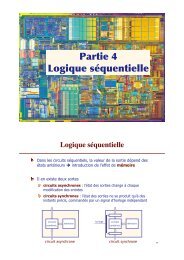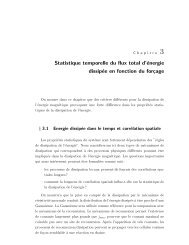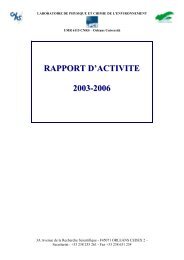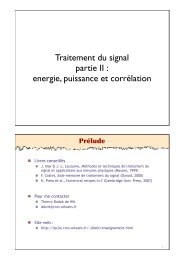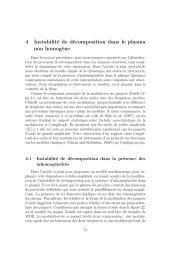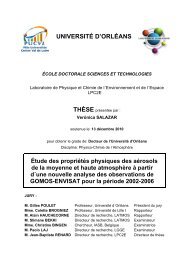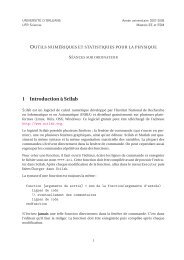UNIVERSITÉ D'ORLÉANS - Laboratoire de physique et chimie de l ...
UNIVERSITÉ D'ORLÉANS - Laboratoire de physique et chimie de l ...
UNIVERSITÉ D'ORLÉANS - Laboratoire de physique et chimie de l ...
You also want an ePaper? Increase the reach of your titles
YUMPU automatically turns print PDFs into web optimized ePapers that Google loves.
1 Introduction<br />
Active chlorine species (Cl, ClO) have been recognized to be very efficient for stratospheric<br />
ozone <strong>de</strong>pl<strong>et</strong>ion (WMO, 2007 and references therein). For a vast majority, they originate from<br />
long-lived source gases (in the troposphere) that release chlorine atoms in the stratosphere,<br />
directly through photodissociation or indirectly through reactions with radicals (e.g., O( 1 D),<br />
OH). The ozone <strong>de</strong>struction catalytic cycles are mainly terminated by recombination reactions<br />
of the Cl atoms with hydrogenated compounds, especially m<strong>et</strong>hane (CH4). These reactions<br />
produce the most abundant stratospheric chlorine reservoir, hydrogen chlori<strong>de</strong> (HCl). Satellite<br />
observations are relevant for providing the total stratospheric chlorine abundance (ClTOT)<br />
through measurements of HCl at high altitu<strong>de</strong>s. In the upper stratosphere ClTOT is dominated<br />
by HCl, which thus serves as a good proxy for estimating this budg<strong>et</strong>. For example,<br />
HCl/ClTOT ratios ranging from 0.89 to 0.98 at ∼46–55 km height have been <strong>de</strong>termined,<br />
<strong>de</strong>pending on the altitu<strong>de</strong> and the latitu<strong>de</strong> (Nassar <strong>et</strong> al., 2006; Froi<strong>de</strong>vaux <strong>et</strong> al., 2006). The<br />
last WMO review (2007), based on the Froi<strong>de</strong>vaux <strong>et</strong> al. (2006) study, compared the HCl<br />
observations from the most recent satellite instruments, including HALogen Occultation<br />
Experiment (HALOE) aboard UARS (Russell <strong>et</strong> al., 1993), Atmospheric Chemistry<br />
Experiment Fourier Transform Spectrom<strong>et</strong>er (ACE-FTS) aboard SCISAT-1 (Bernath <strong>et</strong> al.,<br />
2005) and Microwave Limb Soun<strong>de</strong>r (MLS) aboard EOS Aura (Waters <strong>et</strong> al., 2006). It<br />
highlights that the upper stratospheric HCl measurements agree with each other within the<br />
stated accuracies (at the 2 standard <strong>de</strong>viations (2σ) level), but not sufficiently well to<br />
<strong>de</strong>finitely answer the open questions about chlorine content. In particular, these satellite<br />
observations were compared to calculated HCl volume mixing ratios (vmr) at about 53 km<br />
based on tropospheric source gas (SG) measurements of ground-based n<strong>et</strong>works and<br />
mo<strong>de</strong>lling taking into account the air mixing and the <strong>de</strong>lay for the transport to the<br />
stratosphere. ACE and MLS showed good agreement in 2006 (within 6% at this altitu<strong>de</strong>, i.e.<br />
0.2 parts per billion in volume (ppbv)), with the generally lower MLS values in very good<br />
agreement with HCl vmr <strong>de</strong>rived from the tropospheric data taking into account chlorine<br />
contributions from long-lived source gases (SGs) and 0.10 ppbv from very short-lived<br />
substances (VSLS). In contrast there was a systematic difference in HCl observations of about<br />
0.2–0.4 ppbv (i.e. about 7–15%) b<strong>et</strong>ween MLS and HALOE in 2004–2006, with lower<br />
HALOE values being consistent with supply of chlorine from long-lived source gases only.<br />
These differences preclu<strong>de</strong>d any firm conclusion about a possible total contribution from<br />
111



